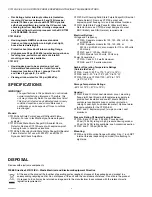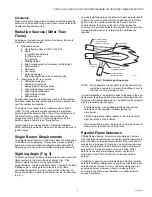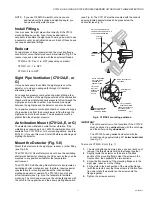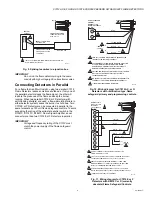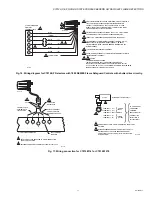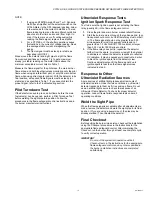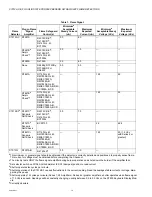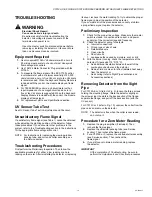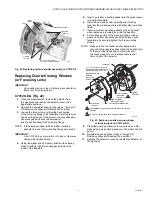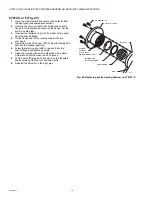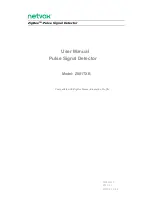
C7012A,C,E,F,G SOLID STATE PURPLE PEEPER® ULTRAVIOLET FLAME DETECTORS
13
60-2398-17
NOTE:
1.
If using an R7247B Ampli-Check™ or C Dynamic
Self-Check Amplifier, set the selector switch on the
W136A Meter to the SPL (damped) position. Allow
a few seconds for the current to stabilize. The red
flame indicating lamp on the amplifier should blink
about one to four times a second (from bright to
dim). If the lamp is on or off continuously while
reading the flame signal, replace the amplifier.
2.
For a C7012E or F, the shutter operation causes
fluctuations in the current or voltage reading. Read
the average stable current, disregarding the
peaks.
3.
The flame signal must be steady (or stable as
described in NOTE 2).
Move around the detector and sight pipe to sight the flame
from various positions and angles. Try to get a maximum
steady (or stable) reading on the meter that is above the
minimum acceptable current listed in Table 1.
Measure the flame signal for the pilot alone, the main burner
flame alone, and both together (unless monitoring only the pilot
flame when using an intermittent pilot, or only the main burner
flame when using direct spark ignition). With the detector in its
final position, all required flame signals must be steady (or
stable) and as specified in Table 1. If you cannot obtain the
proper signal, refer to the Troubleshooting section.
Pilot Turndown Test
If the detector is used to prove a pilot flame before the main
fuel valve(s) can be opened, perform a Pilot Turndown Test
before welding the sight pipe into position. Follow the
procedures in the flame safeguard control instructions and in
the burner manufacturer instructions.
Ultraviolet Response Tests
Ignition Spark Response Test
Test to be sure that ignition spark is not actuating the flame
relay (usually 2K) in the flame safeguard control.
1.
Close the pilot and main burner manual shutoff valves.
2.
Start the burner and run through the Ignition period. Igni-
tion spark should occur, but the flame relay must not pull
in. The flame signal should not be greater than 0.25
microampere for most Honeywell controls and not
greater than 1.0 Vdc for BCS 7700 controls nor larger
than 0.25 Vdc for 7800 Series controls.
3.
If the flame relay does pull in, reposition the detector
farther from the spark, or relocate or resight the detector
to eliminate or reduce the detector response to reflected
UV radiation. It may be necessary to construct a barrier
to block the ignition spark from the detector view.
Continue adjustments until the flame signal due to
ignition spark is less than the flame signal values
indicated in step 2.
Response to Other
Ultraviolet Radiation Sources
Some sources of artificial light produce small amounts of
ultraviolet radiation. Under certain conditions, an ultraviolet
detector responds to them as if it is sensing a flame. Do not
use an artificial light source to check the response of an
Ultraviolet Flame Detector. To check for proper detector
operation, conduct flame failure response tests under all
operating conditions.
Weld the Sight Pipe
When the flame signal is acceptable after all adjustments are
made, remove the detector and weld the sight pipe in its final
position. (If you are using a swivel mount, the pipe may be
already welded.) Then reinstall the detector.
Final Checkout
Before putting the burner into service, check out the installation
using the Checkout procedures in the Instructions for the
appropriate flame safeguard control. After completing the
Checkout, run the burner through at least one complete cycle
to verify correct operation.
IMPORTANT
Do not put the system into operation until all
Checkout tests in the Instructions for the appropriate
flame safeguard control and any others specified in
the burner installation instructions are completed
satisfactorily.


